Amit Agarwal
FlexDoc: Parameterized Sampling for Diverse Multilingual Synthetic Documents for Training Document Understanding Models
Oct 02, 2025Abstract:Developing document understanding models at enterprise scale requires large, diverse, and well-annotated datasets spanning a wide range of document types. However, collecting such data is prohibitively expensive due to privacy constraints, legal restrictions, and the sheer volume of manual annotation needed - costs that can scale into millions of dollars. We introduce FlexDoc, a scalable synthetic data generation framework that combines Stochastic Schemas and Parameterized Sampling to produce realistic, multilingual semi-structured documents with rich annotations. By probabilistically modeling layout patterns, visual structure, and content variability, FlexDoc enables the controlled generation of diverse document variants at scale. Experiments on Key Information Extraction (KIE) tasks demonstrate that FlexDoc-generated data improves the absolute F1 Score by up to 11% when used to augment real datasets, while reducing annotation effort by over 90% compared to traditional hard-template methods. The solution is in active deployment, where it has accelerated the development of enterprise-grade document understanding models while significantly reducing data acquisition and annotation costs.
Hard Negative Mining for Domain-Specific Retrieval in Enterprise Systems
May 23, 2025Abstract:Enterprise search systems often struggle to retrieve accurate, domain-specific information due to semantic mismatches and overlapping terminologies. These issues can degrade the performance of downstream applications such as knowledge management, customer support, and retrieval-augmented generation agents. To address this challenge, we propose a scalable hard-negative mining framework tailored specifically for domain-specific enterprise data. Our approach dynamically selects semantically challenging but contextually irrelevant documents to enhance deployed re-ranking models. Our method integrates diverse embedding models, performs dimensionality reduction, and uniquely selects hard negatives, ensuring computational efficiency and semantic precision. Evaluation on our proprietary enterprise corpus (cloud services domain) demonstrates substantial improvements of 15\% in MRR@3 and 19\% in MRR@10 compared to state-of-the-art baselines and other negative sampling techniques. Further validation on public domain-specific datasets (FiQA, Climate Fever, TechQA) confirms our method's generalizability and readiness for real-world applications.
SweEval: Do LLMs Really Swear? A Safety Benchmark for Testing Limits for Enterprise Use
May 22, 2025Abstract:Enterprise customers are increasingly adopting Large Language Models (LLMs) for critical communication tasks, such as drafting emails, crafting sales pitches, and composing casual messages. Deploying such models across different regions requires them to understand diverse cultural and linguistic contexts and generate safe and respectful responses. For enterprise applications, it is crucial to mitigate reputational risks, maintain trust, and ensure compliance by effectively identifying and handling unsafe or offensive language. To address this, we introduce SweEval, a benchmark simulating real-world scenarios with variations in tone (positive or negative) and context (formal or informal). The prompts explicitly instruct the model to include specific swear words while completing the task. This benchmark evaluates whether LLMs comply with or resist such inappropriate instructions and assesses their alignment with ethical frameworks, cultural nuances, and language comprehension capabilities. In order to advance research in building ethically aligned AI systems for enterprise use and beyond, we release the dataset and code: https://github.com/amitbcp/multilingual_profanity.
FS-DAG: Few Shot Domain Adapting Graph Networks for Visually Rich Document Understanding
May 22, 2025Abstract:In this work, we propose Few Shot Domain Adapting Graph (FS-DAG), a scalable and efficient model architecture for visually rich document understanding (VRDU) in few-shot settings. FS-DAG leverages domain-specific and language/vision specific backbones within a modular framework to adapt to diverse document types with minimal data. The model is robust to practical challenges such as handling OCR errors, misspellings, and domain shifts, which are critical in real-world deployments. FS-DAG is highly performant with less than 90M parameters, making it well-suited for complex real-world applications for Information Extraction (IE) tasks where computational resources are limited. We demonstrate FS-DAG's capability through extensive experiments for information extraction task, showing significant improvements in convergence speed and performance compared to state-of-the-art methods. Additionally, this work highlights the ongoing progress in developing smaller, more efficient models that do not compromise on performance. Code : https://github.com/oracle-samples/fs-dag
Tokenization Matters: Improving Zero-Shot NER for Indic Languages
Apr 23, 2025Abstract:Tokenization is a critical component of Natural Language Processing (NLP), especially for low resource languages, where subword segmentation influences vocabulary structure and downstream task accuracy. Although Byte Pair Encoding (BPE) is a standard tokenization method in multilingual language models, its suitability for Named Entity Recognition (NER) in low resource Indic languages remains underexplored due to its limitations in handling morphological complexity. In this work, we systematically compare BPE, SentencePiece, and Character Level tokenization strategies using IndicBERT for NER tasks in low resource Indic languages like Assamese, Bengali, Marathi, and Odia, as well as extremely low resource Indic languages like Santali, Manipuri, and Sindhi. We assess both intrinsic linguistic properties tokenization efficiency, out of vocabulary (OOV) rates, and morphological preservation as well as extrinsic downstream performance, including fine tuning and zero shot cross lingual transfer. Our experiments show that SentencePiece is a consistently better performing approach than BPE for NER in low resource Indic Languages, particularly in zero shot cross lingual settings, as it better preserves entity consistency. While BPE provides the most compact tokenization form, it is not capable of generalization because it misclassifies or even fails to recognize entity labels when tested on unseen languages. In contrast, SentencePiece constitutes a better linguistic structural preservation model, benefiting extremely low resource and morphologically rich Indic languages, such as Santali and Manipuri, for superior entity recognition, as well as high generalization across scripts, such as Sindhi, written in Arabic. The results point to SentencePiece as the more effective tokenization strategy for NER within multilingual and low resource Indic NLP applications.
Crowdsource, Crawl, or Generate? Creating SEA-VL, a Multicultural Vision-Language Dataset for Southeast Asia
Mar 10, 2025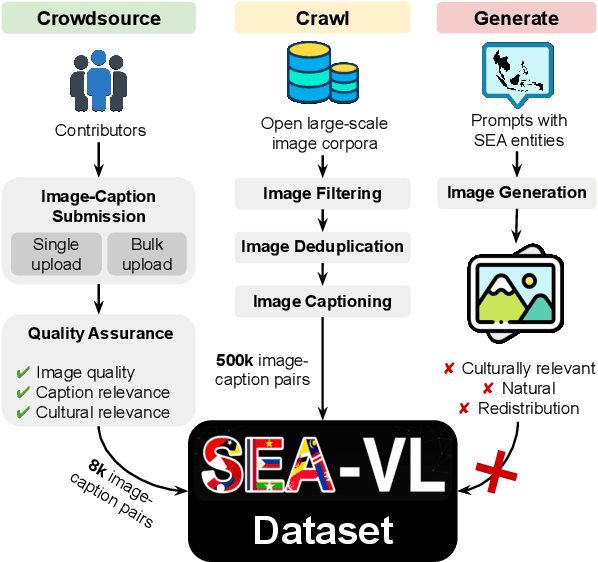
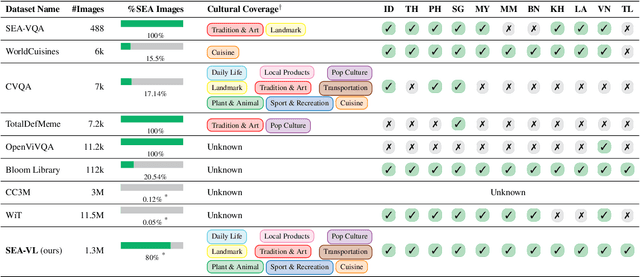


Abstract:Southeast Asia (SEA) is a region of extraordinary linguistic and cultural diversity, yet it remains significantly underrepresented in vision-language (VL) research. This often results in artificial intelligence (AI) models that fail to capture SEA cultural nuances. To fill this gap, we present SEA-VL, an open-source initiative dedicated to developing high-quality, culturally relevant data for SEA languages. By involving contributors from SEA countries, SEA-VL aims to ensure better cultural relevance and diversity, fostering greater inclusivity of underrepresented languages in VL research. Beyond crowdsourcing, our initiative goes one step further in the exploration of the automatic collection of culturally relevant images through crawling and image generation. First, we find that image crawling achieves approximately ~85% cultural relevance while being more cost- and time-efficient than crowdsourcing. Second, despite the substantial progress in generative vision models, synthetic images remain unreliable in accurately reflecting SEA cultures. The generated images often fail to reflect the nuanced traditions and cultural contexts of the region. Collectively, we gather 1.28M SEA culturally-relevant images, more than 50 times larger than other existing datasets. Through SEA-VL, we aim to bridge the representation gap in SEA, fostering the development of more inclusive AI systems that authentically represent diverse cultures across SEA.
Improving Clinical Question Answering with Multi-Task Learning: A Joint Approach for Answer Extraction and Medical Categorization
Feb 18, 2025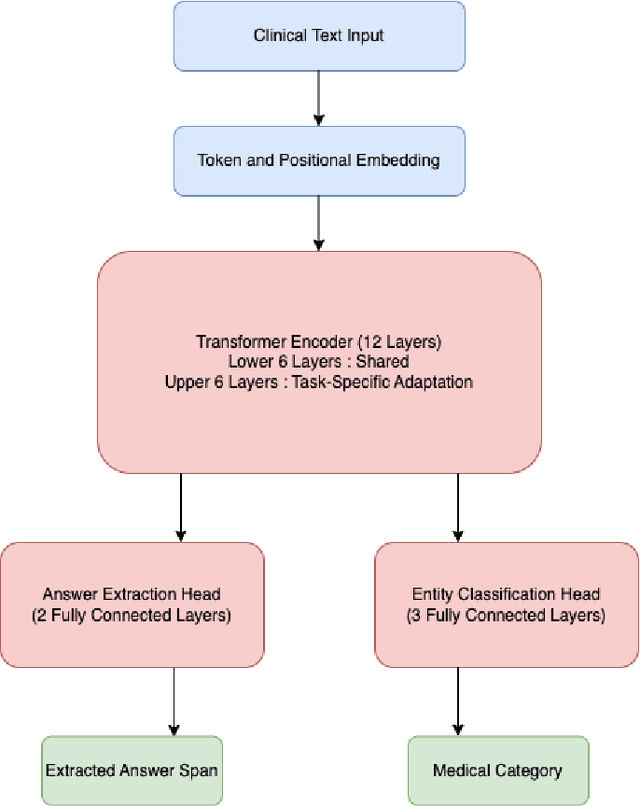
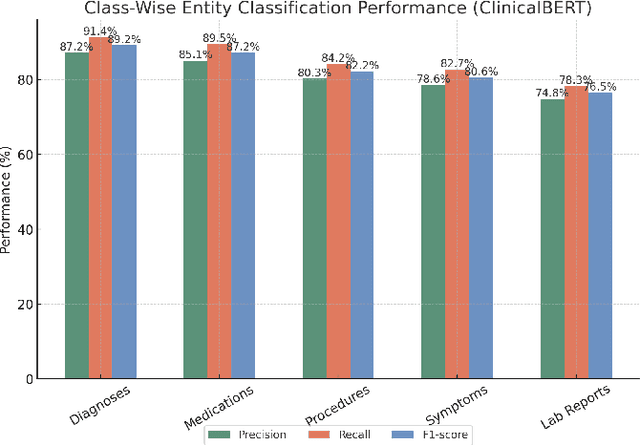

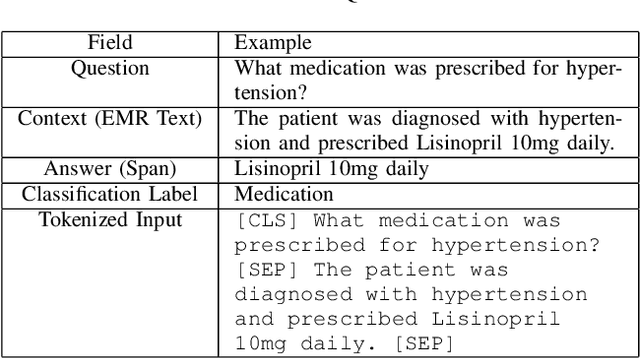
Abstract:Clinical Question Answering (CQA) plays a crucial role in medical decision-making, enabling physicians to extract relevant information from Electronic Medical Records (EMRs). While transformer-based models such as BERT, BioBERT, and ClinicalBERT have demonstrated state-of-the-art performance in CQA, existing models lack the ability to categorize extracted answers, which is critical for structured retrieval, content filtering, and medical decision support. To address this limitation, we introduce a Multi-Task Learning (MTL) framework that jointly trains CQA models for both answer extraction and medical categorization. In addition to predicting answer spans, our model classifies responses into five standardized medical categories: Diagnosis, Medication, Symptoms, Procedure, and Lab Reports. This categorization enables more structured and interpretable outputs, making clinical QA models more useful in real-world healthcare settings. We evaluate our approach on emrQA, a large-scale dataset for medical question answering. Results show that MTL improves F1-score by 2.2% compared to standard fine-tuning, while achieving 90.7% accuracy in answer categorization. These findings suggest that MTL not only enhances CQA performance but also introduces an effective mechanism for categorization and structured medical information retrieval.
MVTamperBench: Evaluating Robustness of Vision-Language Models
Dec 27, 2024Abstract:Recent advancements in Vision-Language Models (VLMs) have enabled significant progress in complex video understanding tasks. However, their robustness to real-world manipulations remains underexplored, limiting their reliability in critical applications. To address this gap, we introduce MVTamperBench, a comprehensive benchmark designed to evaluate VLM's resilience to video tampering effects, including rotation, dropping, masking, substitution, and repetition. By systematically assessing state-of-the-art models, MVTamperBench reveals substantial variability in robustness, with models like InternVL2-8B achieving high performance, while others, such as Llama-VILA1.5-8B, exhibit severe vulnerabilities. To foster broader adoption and reproducibility, MVTamperBench is integrated into VLMEvalKit, a modular evaluation toolkit, enabling streamlined testing and facilitating advancements in model robustness. Our benchmark represents a critical step towards developing tamper-resilient VLMs, ensuring their dependability in real-world scenarios. Project Page: https://amitbcp.github.io/MVTamperBench/
Survey of Large Multimodal Model Datasets, Application Categories and Taxonomy
Dec 23, 2024Abstract:Multimodal learning, a rapidly evolving field in artificial intelligence, seeks to construct more versatile and robust systems by integrating and analyzing diverse types of data, including text, images, audio, and video. Inspired by the human ability to assimilate information through many senses, this method enables applications such as text-to-video conversion, visual question answering, and image captioning. Recent developments in datasets that support multimodal language models (MLLMs) are highlighted in this overview. Large-scale multimodal datasets are essential because they allow for thorough testing and training of these models. With an emphasis on their contributions to the discipline, the study examines a variety of datasets, including those for training, domain-specific tasks, and real-world applications. It also emphasizes how crucial benchmark datasets are for assessing models' performance in a range of scenarios, scalability, and applicability. Since multimodal learning is always changing, overcoming these obstacles will help AI research and applications reach new heights.
Enhancing Document AI Data Generation Through Graph-Based Synthetic Layouts
Nov 27, 2024Abstract:The development of robust Document AI models has been constrained by limited access to high-quality, labeled datasets, primarily due to data privacy concerns, scarcity, and the high cost of manual annotation. Traditional methods of synthetic data generation, such as text and image augmentation, have proven effective for increasing data diversity but often fail to capture the complex layout structures present in real world documents. This paper proposes a novel approach to synthetic document layout generation using Graph Neural Networks (GNNs). By representing document elements (e.g., text blocks, images, tables) as nodes in a graph and their spatial relationships as edges, GNNs are trained to generate realistic and diverse document layouts. This method leverages graph-based learning to ensure structural coherence and semantic consistency, addressing the limitations of traditional augmentation techniques. The proposed framework is evaluated on tasks such as document classification, named entity recognition (NER), and information extraction, demonstrating significant performance improvements. Furthermore, we address the computational challenges of GNN based synthetic data generation and propose solutions to mitigate domain adaptation issues between synthetic and real-world datasets. Our experimental results show that graph-augmented document layouts outperform existing augmentation techniques, offering a scalable and flexible solution for training Document AI models.
* Published in IJERT, Volume 13, Issue 10 (October 2024)
 Add to Chrome
Add to Chrome Add to Firefox
Add to Firefox Add to Edge
Add to Edge